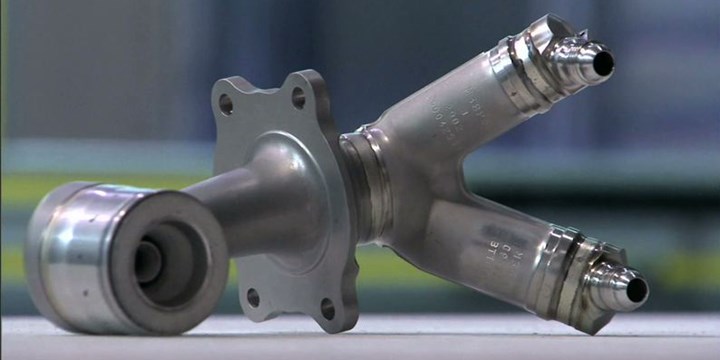GE Brings Production-Volume Additive Manufacturing to Alabama
Company says the site could ultimately have 50 additive manufacturing machines. Nozzles made here will be shipped to an even newer manufacturing site in Indiana.

GE Aviation has announced that the LEAP engine fuel nozzle—the nozzle (shown) with a design made possible by additive manufacturing—will be mass-produced in Auburn, Alabama, starting next year. Up to 10 additive manufacturing machines will be installed at the company’s plant in Auburn, which was opened last year.
Additive manufacturing capacity will increase from there, the company says. Production demand for the new fuel nozzle is scheduled to ascend steeply, growing from an initial rate of 1,000 units per year to 40,000 per year by 2020. GE says the Auburn site could ultimately have more than 50 additive manufacturing machines, with nozzle production expanding to occupy a third of the facility.
Those nozzles will be sent to an even newer engine production plant in Lafayette, Indiana, that is scheduled to open next year. This $100 million plant, which will include both CNC machining and assembly, will be the seventh new U.S. manufacturing site in seven years for GE Aviation.
Related Content
-
This Drone Bird with 3D Printed Parts Mimics a Peregrine Falcon: The Cool Parts Show #66
The Drone Bird Company has developed aircraft that mimic birds of prey to scare off problem birds. The drones feature 3D printed fuselages made by Parts on Demand from ALM materials.
-
3D Printing with Plastic Pellets – What You Need to Know
A few 3D printers today are capable of working directly with resin pellets for feedstock. That brings extreme flexibility in material options, but also requires greater knowledge of how to best process any given resin. Here’s how FGF machine maker JuggerBot 3D addresses both the printing technology and the process know-how.
-
VulcanForms Is Forging a New Model for Large-Scale Production (and It's More Than 3D Printing)
The MIT spinout leverages proprietary high-power laser powder bed fusion alongside machining in the context of digitized, cost-effective and “maniacally focused” production.











